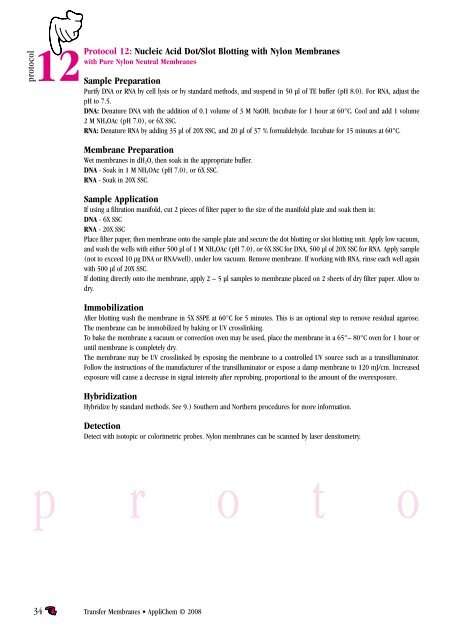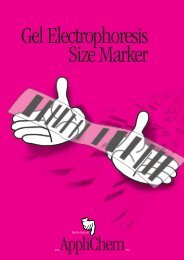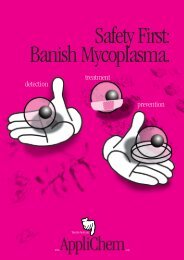Transfer Membranes
Transfer Membranes
Transfer Membranes
You also want an ePaper? Increase the reach of your titles
YUMPU automatically turns print PDFs into web optimized ePapers that Google loves.
protocol<br />
12<br />
Protocol 12: Nucleic Acid Dot/Slot Blotting with Nylon <strong>Membranes</strong><br />
with Pure Nylon Neutral <strong>Membranes</strong><br />
Sample Preparation<br />
Purify DNA or RNA by cell lysis or by standard methods, and suspend in 50 µl of TE buffer (pH 8.0). For RNA, adjust the<br />
pH to 7.5.<br />
DNA: Denature DNA with the addition of 0.1 volume of 3 M NaOH. Incubate for 1 hour at 60°C. Cool and add 1 volume<br />
2 M NH 4OAc (pH 7.0), or 6X SSC.<br />
RNA: Denature RNA by adding 35 µl of 20X SSC, and 20 µl of 37 % formaldehyde. Incubate for 15 minutes at 60°C.<br />
Membrane Preparation<br />
Wet membranes in dH 2O, then soak in the appropriate buffer.<br />
DNA - Soak in 1 M NH 4OAc (pH 7.0), or 6X SSC.<br />
RNA - Soak in 20X SSC.<br />
Sample Application<br />
If using a filtration manifold, cut 2 pieces of filter paper to the size of the manifold plate and soak them in:<br />
DNA - 6X SSC<br />
RNA - 20X SSC<br />
Place filter paper, then membrane onto the sample plate and secure the dot blotting or slot blotting unit. Apply low vacuum,<br />
and wash the wells with either 500 µl of 1 M NH 4OAc (pH 7.0), or 6X SSC for DNA, 500 µl of 20X SSC for RNA. Apply sample<br />
(not to exceed 10 µg DNA or RNA/well), under low vacuum. Remove membrane. If working with RNA, rinse each well again<br />
with 500 µl of 20X SSC.<br />
If dotting directly onto the membrane, apply 2 – 5 µl samples to membrane placed on 2 sheets of dry filter paper. Allow to<br />
dry.<br />
Immobilization<br />
After blotting wash the membrane in 5X SSPE at 60°C for 5 minutes. This is an optional step to remove residual agarose.<br />
The membrane can be immobilized by baking or UV crosslinking.<br />
To bake the membrane a vacuum or convection oven may be used, place the membrane in a 65°– 80°C oven for 1 hour or<br />
until membrane is completely dry.<br />
The membrane may be UV crosslinked by exposing the membrane to a controlled UV source such as a transilluminator.<br />
Follow the instructions of the manufacturer of the transilluminator or expose a damp membrane to 120 mJ/cm. Increased<br />
exposure will cause a decrease in signal intensity after reprobing, proportional to the amount of the overexposure.<br />
Hybridization<br />
Hybridize by standard methods. See 9.) Southern and Northern procedures for more information.<br />
Detection<br />
Detect with isotopic or colorimetric probes. Nylon membranes can be scanned by laser densitometry.<br />
p r o t o<br />
34 <strong>Transfer</strong> <strong>Membranes</strong> • AppliChem © 2008





